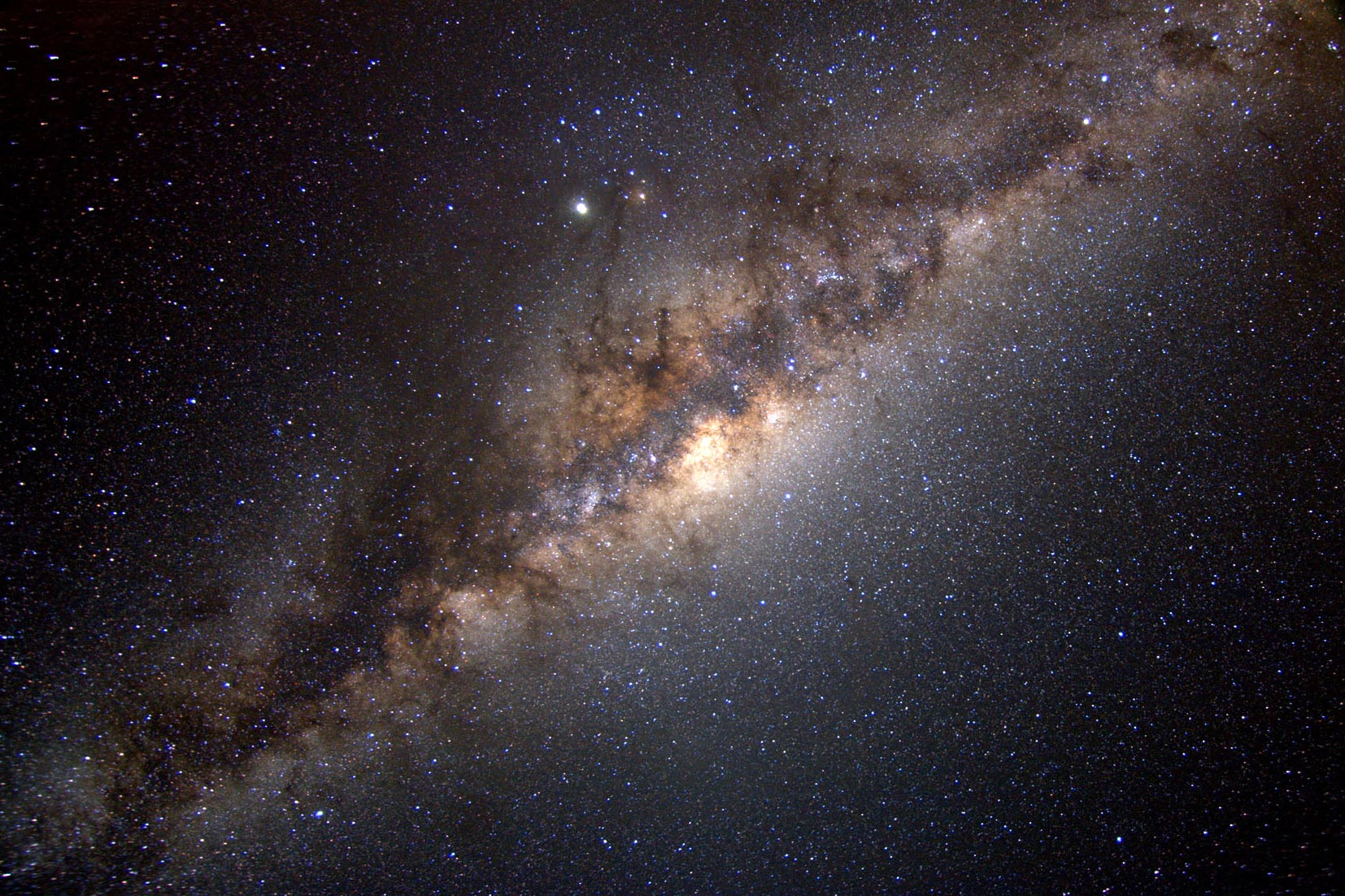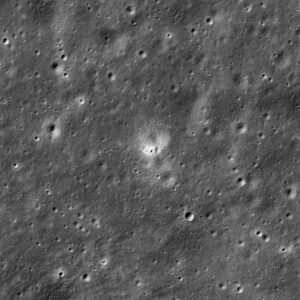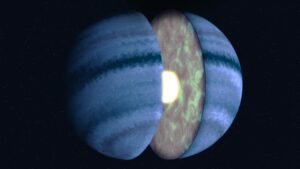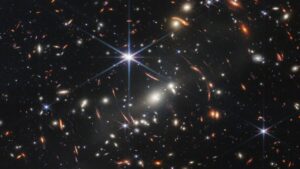MIT astronomers have discovered three of the oldest stars in the universe, and they live in our own galactic neighborhood. The stars are in the Milky Way’s ‘halo’ – the cloud of stars that surrounds the main galactic disk – and appear to have formed between 12 and 13 billion years ago, when the first galaxies were forming. Credit: Serge Brunier; NASA
Astronomers have discovered three ancient stars orbiting around Milky Wayhalo formed 12-13 billion years ago.
MIT researchers have discovered three of the oldest stars in the universe, and they happen to live in our own galactic neighborhood.
The team, which included several students, spotted the stars in the Milky Way’s “halo,” the cloud of stars that envelops the entire main galactic disk. Based on the team’s analysis, the three stars formed between 12 and 13 billion years ago, the time when the first galaxies were forming.
The researchers coined the “SASS” stars to be stars from a small accreted star system, as they believe that each star once belonged to its own small, primitive galaxy that was later swallowed up by the larger, but still growing, Milky Way. way. Today, the three stars are all that remain of their respective galaxies. They circle the outskirts of the Milky Way, where the team suspects there may be more such survivors of ancient stars.
A new method for studying ancient stars
“These oldest stars should definitely be there, given what we know about galaxy formation,” says MIT physics professor Anna Froebel. “They are part of our cosmic family tree. And now we have a new way to find them.
As they discover similar SASS stars, the researchers hope to use them as analogues of ultrafaint dwarf galaxies, which are thought to be some of the first surviving galaxies in the Universe. Such galaxies are still intact today, but they are too distant and faint for astronomers to study in depth. Since the SASS stars may have once belonged to similar primitive dwarf galaxies, but are in the Milky Way and as such much closer, they could be an accessible key to understanding the evolution of ultrafaint dwarf galaxies.
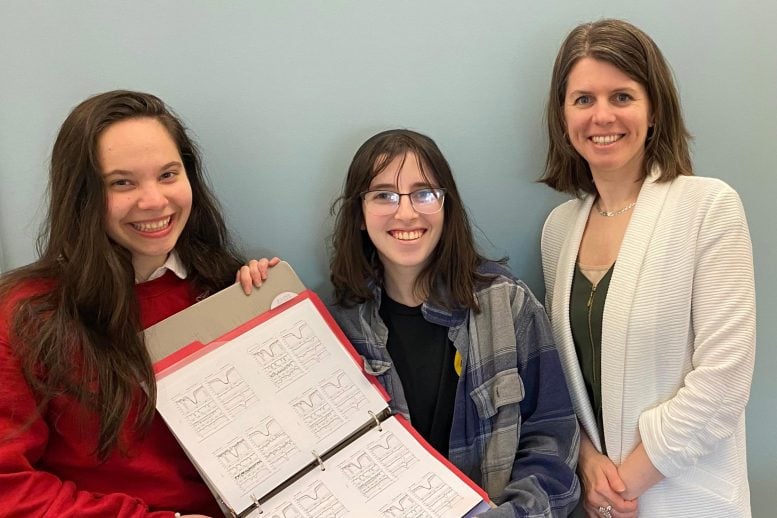
The researchers keep a binder full of star data they’ve collected over the years, including the star’s brightness over time. Left to right: Ananda Santos, Casey Fienberg and Anna Froebel. Credit: Courtesy of the researchers
“We can now look for more counterparts in the Milky Way, which are much brighter, and study their chemical evolution without having to chase these extremely faint stars,” Froebel says.
She and her colleagues published their findings on May 14 in Monthly Notices of the Royal Astronomical Society (MNRAS). Co-authors of the study are Mohammad Mardini of Zarqa University, Jordan; Hilary Andalis ’23; and current MIT students Ananda Santos and Casey Feinberg.
The concept of the classroom leads to a great discovery
The team’s findings grew out of a classroom concept. In the fall semester of 2022, Froebel launched a new course, 8.S30 (Observational Stellar Archaeology), in which students learned techniques for analyzing ancient stars and then applied those tools to stars that had never been studied before to determine their origin.
“Although most of our classes are taught from the ground up, this class immediately puts us on the cutting edge of astrophysics research,” Andales says.
The students worked on stellar data collected by Froebel over the years from the 6.5-meter Magellan-Clay telescope at Las Campanas Observatory. She keeps hard copies of the data in a large binder in her office, which students comb through to look for stars of interest.
In particular, they looked for ancient stars that formed soon after Big bang, happened 13.8 billion years ago. At that time, the universe was made up mostly of hydrogen and helium and very little of other chemical elements, such as strontium and barium. So the students searched the Froebel binder for stars with spectra, or measurements of starlight, that showed low levels of strontium and barium.
Analyzing ancient stars
Their search narrowed down to three stars that were originally observed by the Magellan telescope between 2013 and 2014. Astronomers had never tracked these particular stars to interpret their spectra and infer their origins. Then they were ideal candidates for students in Froebel’s class.
Students learned how to characterize a star in preparation for analyzing the spectra of each of the three stars. They were able to determine the chemical composition of each with different star patterns. The intensity of a particular feature in the stellar spectrum corresponding to a particular wavelength of light corresponds to a particular abundance of a particular element.
After finalizing their analysis, the students were able to confidently conclude that the three stars contained very low levels of strontium, barium and other elements such as iron, compared to their reference star, our own sun. In fact, a star contains less than 1/10,000 the amount of iron to helium compared to the sun today.
“It took many hours of staring at a computer and a lot of debugging, frantically texting and emailing each other to figure this out,” Santos recalls. “It’s been a big learning curve and a special experience.”
“On the Run”
The stars’ low chemical abundances indeed suggest that they originally formed 12 to 13 billion years ago. In fact, their low chemical signatures were similar to what astronomers had previously measured for some ancient, ultrafaint dwarf galaxies. Do the team’s stars originate from similar galaxies? And how did they end up in the Milky Way?
On a hunch, scientists checked the stars’ orbital patterns and how they move across the sky. The three stars are at different locations in the Milky Way’s halo and are estimated to be about 30,000 light-years from Earth. (For reference, the Milky Way disk spans 100,000 light years.)
As they tracked the motion of each star around the galactic center using observations from the Gaia astrometric satellite, the team noticed a curious thing: compared to most of the stars in the main disk, which move like cars on a race track, all three stars seemed to be going the wrong way. In astronomy, this is known as “retrograde motion” and is a signal that an object was once “grown” or attracted from elsewhere.
“The only way to get the stars to move the wrong way from the rest of the gang is if you throw them the wrong way,” Froebel says.
Future perspectives and research
The fact that these three stars orbited in completely different ways from the rest of the galactic disk and even from the halo, combined with the fact that they were low in chemicals, made a strong case that the stars were indeed ancient and once belonged to a more old, smaller dwarf galaxies that fell into the Milky Way at random angles and continued on their stubborn trajectories billions of years later.
Froebel, curious if retrograde motion was a feature of other ancient stars in the halo that astronomers had previously analyzed, scoured the scientific literature and found 65 other stars, also low in strontium and barium, that also appeared to contradict a galactic flow.
“The interesting thing is that they are all quite fast – hundreds of kilometers per second, going in the wrong direction,” says Froebel. “They’re running! We don’t know why, but it was the piece of the puzzle that we needed and that I didn’t quite expect when we started.”
The team is eager to search for other ancient SASS stars, and now they have a relatively simple recipe for doing so: First, look for stars with low chemical content, and then track their orbital patterns for signs of retrograde motion. Of the more than 400 billion stars in the Milky Way, they expect the method will find a small but significant number of the oldest stars in the universe.
Froebel plans to resume the class this fall and looks back on that first year and the three students who brought their results to publication with admiration and gratitude.
“It was great to work with three female students. This is a first for me,” she says. “This really exemplifies the MIT way. We are doing. And whoever says, “I want to participate,” can do it, and good things happen.
Reference: “The Oldest Low Neutron-Capture Element Abundance Stars and Origins of Ancient Dwarf Galaxies” by Hilary Diane Andales, Ananda Santos Figueiredo, Casey Gordon Fienberg, Mohammad K. Mardini, and Anna Froebel, May 14, 2024. Monthly Notices of the Royal Astronomical Society.
DOI: 10.1093/mnras/stae670
This research was supported in part by the National Science Foundation.
